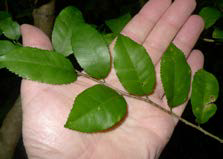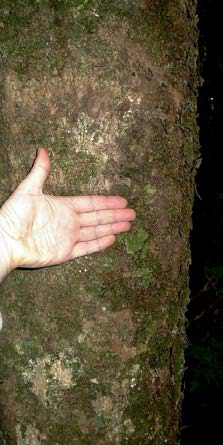Trip Report – 4 July 2015 : Porirua Scenic Reserve – Rangituhi Crescent entrance
 |
Figure 1. Large-leaved milk tree, Streblus banksii.
|
We found our 2014 trip to Porirua Scenic Reserve so interesting that we went back. On 2 August 2014 we had entered it near Camp Elsdon; this year we entered it from Rangituhi Crescent. We walked up the track until it peaked, and then retraced our steps.
The recent flooding had damaged the small stream and the grassy clearing at the track’s entrance. The surrounding plants looked to have stood up well, at least those which had not had their substrate ripped away.
More large podocarps were evident along this track, compared with the track from Camp Elsdon. Matai was the most common, with some kahikatea, mostly in the valley, and an occasional miro and totara. Many of these trees were remarkably squat – short for their girth – reflecting the low canopy, and perhaps a windiness that makes it difficult for emergents. Kohekohe made up most of the canopy, and it was just past its flowering peak.
At a clearing a little way up the track, we looked out at the canopy on the opposite hillside and practised our long-distance identifications. We seemed to be quite good (or otherwise all wrong).
 |
Figure 2. Trunk of large lancewood, Pseudopanax crassifolius, some 35-40cm in diameter. Dawson & Lucas (2011, New Zealand’s Native Trees) indicate it can reach 50cm!
|
Among the highlights we saw from the track were large-leaved milk tree /
Streblus banksii (Fig. 1). These were not uncommon, once we got our eye in for them. We also found a cluster of very large lancewoods /
Pseudopanax crassifolius near the top of the track (Fig. 2). Nikau were abundant at higher altitudes. Weeds were generally inconspicuous. With the reserve previously botanised thoroughly by Pat Enright and colleagues, there were few additions to the list:
Pseudopanax crassifolius x
P. lessonii, Japanese hill cherry /
Prunus serrulata (?), Cape gooseberry /
Physalis peruviana, Mexican daisy /
Erigeron karvinskianus, velvety nightshade /
Solanum chenopodioides, and hawksbeard /
Crepis capillaris.
Fern focus for the day was
Adiantum. The reserve is home to four indigenous species; few NZ sites outside the northern North Island could match that. We encountered both
A. fulvum and
A. viridescens; the latter seemed to be more common.
The hairs on the axes (rachis and costae) distinguish both from the glabrous, and usually more abundant,
A. cunninghamii.
Adiantum fulvum has hairs on the underside of the frond segments, while
A. viridescens does not. I could see the hairs on the plants I claimed to be
A. fulvum, but no-one else could.
Photos of some of what we saw are available on NatureWatch at:
http://naturewatch.org.nz/observations?utf8=%E2%9C%93&q=WellingtonBotanicalSociety+July2015.
Participants: Bev Abbott, Eleanor Burton, Gavin Dench, Richard Grasse, Chris Hopkins, Chris Horne, Jane Humble, Barbara Mitcalfe, Chris Moore, Mike Orchard, Phil Parnell, Leon Perrie (co-leader / scribe), Nick Saville, Lara Shepherd (co-leader), Sunita Singh, Roy Slack, Julia White, Kate Zwartz.

 Site Index
Site Index







 Site Index
Site Index





